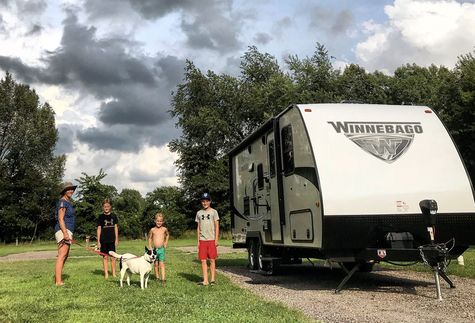The Amish people are a devout Christian group known for their traditional lifestyles and rejection of modern conveniences.
First arriving in the U.S. from Europe in the 1700s, the Amish were members of a strict Mennonite sect, founded by Swiss preacher Jakob Amman. The name “Amish” is derived from his name.
“As part of their Ordnung (a collection of guidelines for how Amish should live), Old Order Amish forbid owning automobiles, tapping electricity from public utility lines, owning televisions, radios, or personal computers, attending high school or college, joining the military, and initiating divorce,” according to a report by the Young Center for Anabaptist and Pietist studies in Elizabethtown, Pennsylvania.
While the largest Amish communities inhabit rural areas of Pennsylvania, Ohio, Indiana and Illinois, the Federal Highway Administration's Scenic Byways Program promotes Holmes County, Ohio with its own Amish Country Byway.
The 190-mile byway is not a single roadway, but a collection of 13 different state and federal routes that crisscross different areas of Holmes County, passing through the towns of Wilmot, Walnut Creek, Berlin, Millersburg, Killbuck, Loudonville and Brinkhaven. These roadways not only offer RV enthusiasts scenic views of rolling hills and covered bridges — and opportunities to see Amish people traveling about in horse-drawn buggies — but many locations to enjoy Amish history and culture such as restaurants, antique stores, and other small family businesses. Attractions include:
- Amish and Mennonite Heritage Center in Millersburg: A focal point of the center is a 10-foot-tall by 265-foot-long cyclorama or “mural-in-the-round.” The cyclorama is called “Behalt,” which means “to keep” or “to remember.”
“Behalt illustrates the heritage of the Amish and Mennonite people from their Anabaptist beginnings in Zürich, Switzerland in 1525 to the present day,” the center states on its website. “The story is told within the development of the early Christian church, the acceptance of Christianity by the Roman Empire under Constantine, and the growth of Roman Catholicism. Following the depiction of the first documented adult baptisms in modern times in Zürich in 1525, the cyclorama continues to follow the spread of the Anabaptist movement throughout the world. From this movement sprang the Mennonites, Amish and Hutterite people.” The Center notes that there are now more than 1.6 million Anabaptists living in 80 countries. “At least 60% are African, Asian, or Latin American,” the Center writes.
- Helping Hands Quilty Shop in Berlin: As Berlin’s original quilt shop, Helping Hands carries the highest quality fabric and notions as well as books, patterns, locally made finished quilts and other items. The shop was founded in 1974 by Alma Mullet and expanded into its current location on the site of the former public library in 1997. Purchased by the Dennis Mullet family in 2011, Helping Hands continues to preserve Amish Country quilting traditions in Berlin while growing to accommodate new trends, skills, and products in the quilting market. The shop features over 3,000 bolts of fabric, plus notions, stencils, frames, and embroidery.
- German Culture Museum in Walnut Creek: The museum houses an impressive collection of area memorabilia and displays of Amish, German, and Swiss heritage. Focusing specifically on the history and settlement of Holmes County and Walnut Creek Township, the museum provides a snapshot of life in the 19th and 20th centuries. Visitors are greeted by knowledgeable volunteers at our entry desk, where a portrait of Jonas Stutzman is featured. Jonas is considered to be the "Father of Amish Country.” Along with Stutzman artifacts, visitors can see rooms that tell the story of everyday life in bygone times.
- Troyer's Amish Tours: This company creates informational dinners and private dinners for visitors to Amish Country.
- Yoder's Amish Home in Millersburg: The tour features two homes, local guides who explain the Amish culture and lifestyle, a barn with an animal petting area, buggy rides, school house tours, a gift shop, and covered picnic area.
VisitAmishCountry.com offers ideas on interesting things to see and do that go beyond Amish history and culture, including:
- Harvest Ridge Event Center in Millersburg: This community event center, which features gardens, expo buildings, a rustic barn and campsites, is the venue for many significant events, including the annual Holmes County Fair in August. A focal point of the event center is the Shreiner Barn, which was built in the 1800s and restored in 2013. The barn is home to the Holmes County Historical Society Agriculture History display, which shows the history of local barns and agriculture throughout Holmes County. This award-winning exhibit features an 1861 map of Holmes County, the oldest one still in existence. A timeline spanning several centuries runs the length of the map and shows national, Ohio and local agriculture related events. Old ads of agriculture equipment and events from the 1800s are also part of the exhibit.
- Heini’s Cheese Chalet in Millersburg: This shop has been crafting artisan-style cheeses since 1935. They still use local dairy, and you can watch the cheesemaking process if you arrive in the morning. The shop offers over 50 sampling varieties, so you can try and buy your favorites. They also feature locally made jams and jellies, as well as some bulk food items.
- Holmes County Pottery in Big Prairie: This unique store features handmade pottery thrown on the potters wheel with Ohio clay and fired in a 400 cubic foot wood burning kiln. Pottery items include tableware, baking dishes, and planters.
- Killbuck Valley Historical Society and Museum in Killbuck: This museum showcases the natural and cultural history of the Killbuck region and Holmes County with collections of arrowheads, rocks, and tools. The taxidermy section of the museum hosts an array of animals that live or lived locally, from birds of all species to the small game that roamed the swamps and field of Holmes County. The museum also has many rotating displays that they showcase each year.
-
- Millers Bakery in Millersburg: Operating since 1967, this is Holmes County's oldest bakery, offering doughnuts, cream sticks, twists, fritters, breads, pies, cookies, tarts, noodles, and fry pies — all made from scratch.
- Millersburg Glass Museum in Millersburg: This museum features the largest public display of Millersburg Carnival and Crystal Glass produced between 1909-1912. Millersburg glass is highly sought after because it was only produced during a four-year-period. Millersburg glass was the brainchild of John W. Fenton, the brother of Frank L. Fenton, with whom he had worked at the Fenton Art Glass Company. “Millersburg Glass Company was extremely short-lived and it still has an air of mystery about it,” according to a historical report on the museum’s website, which noted that the company filed for bankruptcy in 1911 and closed the following year. “The high quality of their glass, the short period of production and the difficulties of the latter years have all combined to make much of Millersburg’s Carnival Glass somewhat scarce and much sought-after,” the report states.
- Pro Football Hall of Fame in Canton: The Hall of Fame pays tribute to the talents and triumphs of pro football’s greatest legends.
- Mohican State Park: this park offers thousands of wooded acres and water attractions, including Clear Fork Gorge and Lyon’s Falls. This park also has an onsite campground with a swimming pool. Nearby Pleasant Hill Lake, which is managed by the Muskingum Watershed Conservancy District, offers boating with no horsepower limits. A portion of the lake is no-wake speed, enjoyed by paddlers and anglers alike.
There are also a wide variety of campgrounds near and along the Amish Country Byway, including:
















